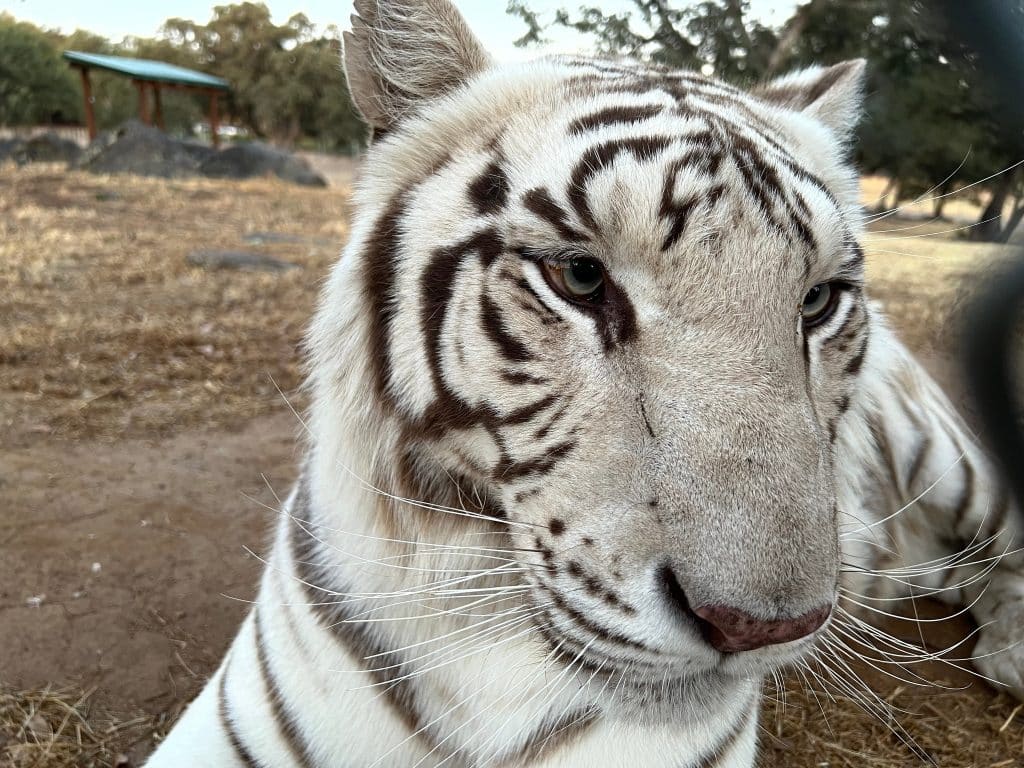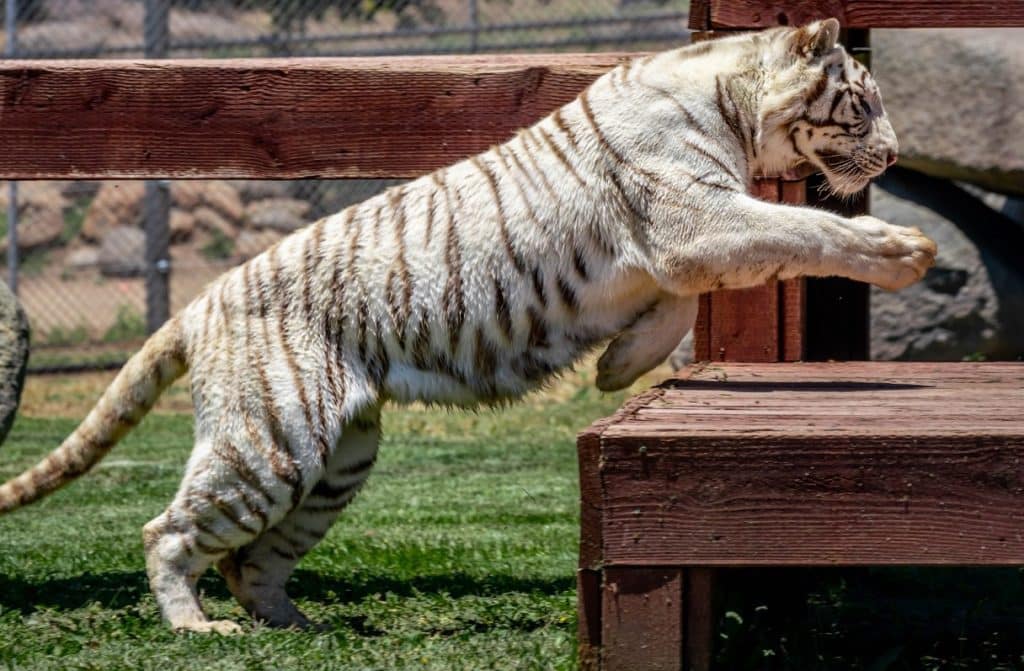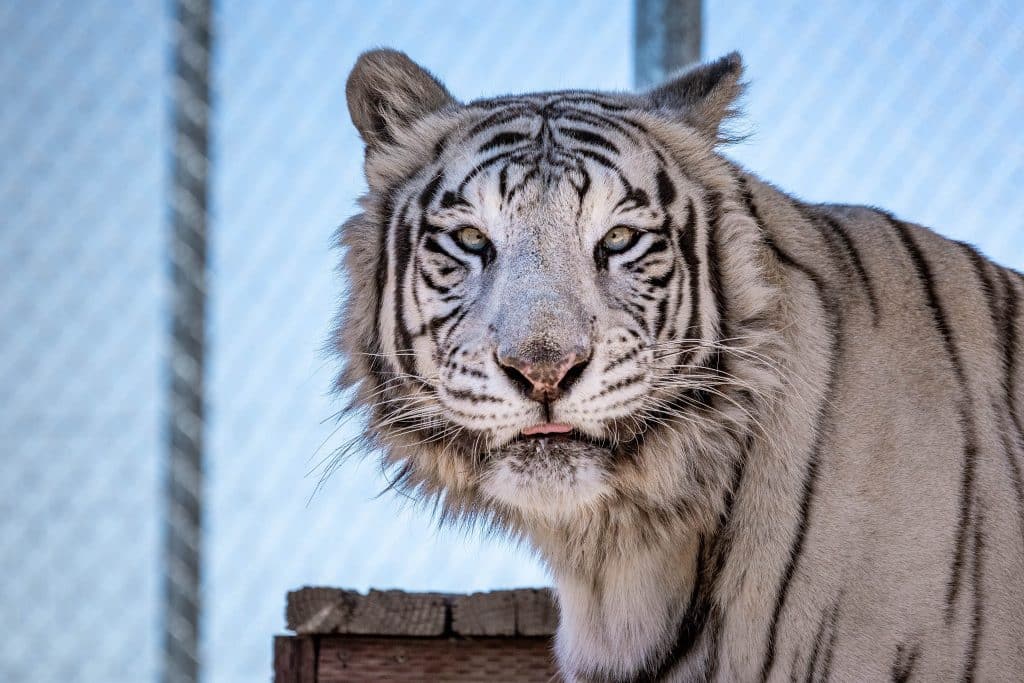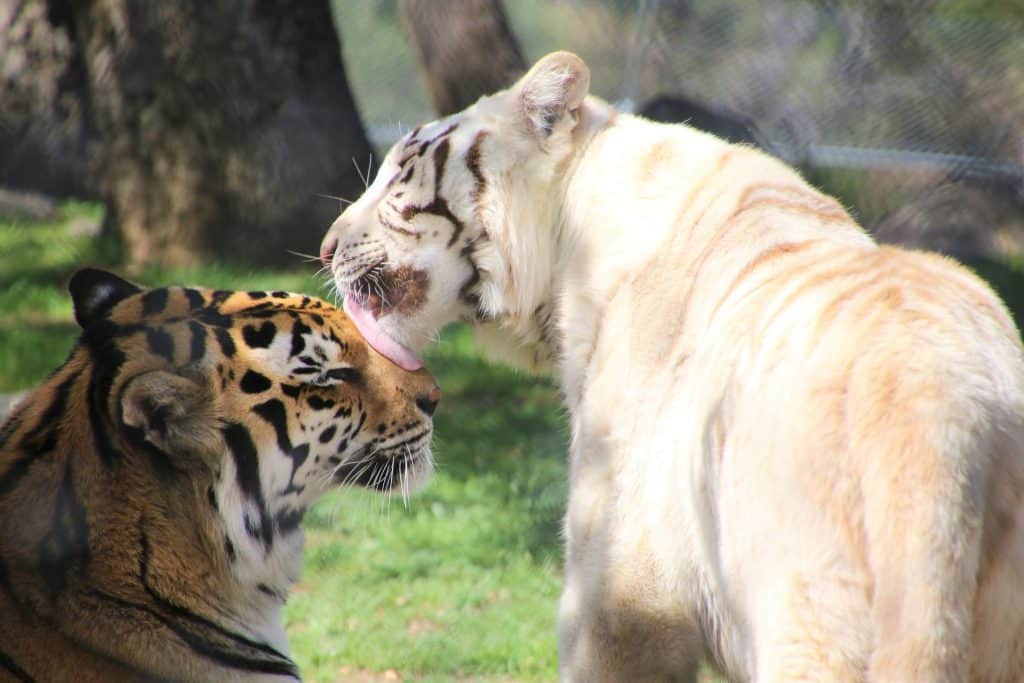
White tigers are incredibly rare, and only a handful of them have ever been spotted in the wild. Contrary to common belief, these majestic animals are not albino or distinct subspecies of tigers; instead, they are Bengal or Siberian tigers carrying a rare genetic mutation known as leucism. This mutation affects the pigmentation of their fur, resulting in a distinctive white coat. According to wildlife experts, leucism happens in only 1 out of 10,000 tiger births.
Unfortunately for these tigers, the white coat does not provide any evolutionary advantage in the wild. In fact, it puts them at a significant disadvantage. Unlike their orange counterparts, whose coats blend seamlessly with their natural surroundings, white tigers stand out conspicuously, making them easy targets for predators and diminishing their ability to hunt successfully.
However, perhaps the most insidious threat comes from the captive breeding industry, where these rare animals are exploited for profit under the guise of conservation. For years, exhibitors and breeders have used the excuse that white tigers are an endangered species and need breeding to conserve them. But the truth is that breeding white tigers doesn’t contribute to any conservation effort and is only done for one reason: money.
The existence of white tigers in captivity is solely due to selective breeding practices that involve inbreeding. Inbreeding is the mating of closely related tigers, such as father and daughter or father and granddaughter, to increase the chances of offspring inheriting the recessive gene responsible for white coloration.
Inbreeding increases the chances of genetic disorders, deformities, and other major health problems due to the lack of genetic diversity. This means that these tigers are often born with severe health conditions and deformities that result in a lifetime of chronic pain and suffering. Common issues include heart defects, optic nerve damage, immune system deficiencies, shortened limbs, cleft palates, etc. Still, you’ll never see these on big cat Instagram accounts because they’re often hidden away or euthanized.
According to reports, the neonatal mortality rate of white tigers exceeds 80%. Breeders have to breed a lot of tigers to get one perfect one, but in the process, a surplus of orange and imperfect white tigers are born. And since they’re often unwanted, they’re disposed of by any possible means. This is one of the reasons why we have more tigers in captivity today than in the wild.

Captive tiger cubs are prized commodities for facilities that own them, as they attract revenue through photo opportunities and interactions with paying customers. Notable figures like Siegfried and Roy exemplify this trend, where the allure of showcasing exotic animals for entertainment purposes often overshadows the imperative to contribute meaningfully to conservation initiatives. In the case of Siegfried and Roy, their famous Las Vegas shows featuring white lions and white tigers became synonymous with spectacle and extravagance.
However, funds generated from such activities never seem to reach the conservation projects they claim to support. As these tiger cubs mature into adults, the costs of their care escalate, requiring more extensive and more secure enclosures. To mitigate these expenses, some facilities resort to unethical practices like euthanizing surplus adult tigers and selling their parts on the illegal tiger trade market, doubling their profits.
The truth is that- white tigers are not even endangered to begin with. Their white and black stripes are just an anomaly that does not need conservation. But for as long as these facilities continue to sell tigers along with their parts, there will always be demand, and that will put wild tigers at risk.
So basically, when you pay to see or play with a white Siberian tiger or Bengal tiger, you are not really helping conserve tigers in the wild. As mentioned, these tigers are a novelty with no conservation value whatsoever. If anything, their exploitation for profit contributes to the perpetuation of harmful practices and poses a threat to the wild tiger population.
Today, there are more tigers in captivity than there are in the wild. While climate change plays a part, poaching and hunting are the biggest threats to the survival of wild exotic animals like tigers.

Tigers and other endangered wild animals face a range of challenges, including the negative effect of breeding with close genetic relatives. Here’s a look at some of these effects:
Inbreeding results in a decrease in genetic diversity within a population. When closely related tigers mate, they pass on a limited set of genetic variations to their offspring. Over time, this leads to a population with a restricted gene pool, making it more vulnerable to environmental changes, diseases, and other threats. Reduced genetic diversity diminishes the adaptive potential of the population, making it less able to respond to changes in the environment.
Inbreeding can amplify the expression of harmful genetic traits. Recessive genes carrying deleterious traits become more likely to be expressed when tigers with similar genetic backgrounds mate. This can lead to a higher incidence of genetic disorders, congenital abnormalities, and other health issues among offspring. As a result, inbred populations may experience reduced fitness and reproductive success, further exacerbating population declines.
Inbreeding poses challenges for captive breeding programs aimed at reintroducing endangered species into the wild. Inbred tigers may have reduced fitness and genetic health, making them less suitable for release into natural habitats. Conservation breeding programs must carefully manage genetic diversity to avoid the negative consequences of inbreeding and maintain the long-term viability of captive populations.

The exploitation of white tigers for profit under the guise of conservation is a pressing concern that undermines genuine efforts to preserve tiger species in the wild. Inbreeding, driven by the demand for white tiger cubs in captivity, perpetuates harmful genetic traits and health issues and also contributes to the surplus of captive tigers and the highly unethical practices associated with their disposal.
As a result, conservation efforts must prioritize addressing the root causes of exploitation, including the demand for tiger parts and the commercialization of captive tigers, to effectively protect wild tiger populations from the threats of poaching, habitat loss, and human-wildlife conflict.
Lions Tigers & Bears helps rescue and rehabilitate tigers and other wild animals from exploitative situations. We prioritize the welfare and well-being of captive tigers, providing them with spacious and enriching habitats where they can live out their lives free from exploitation and abuse. We also strive to raise awareness about the plight of tigers in the wild and advocate for stronger conservation measures to protect their natural habitats and combat illegal poaching and trade.
Supporting an accredited sanctuary like Lions Tigers & Bears is crucial in ensuring the well-being and protection of rescued animals. Your donations help provide essential care, veterinary services, and enrichment activities for these majestic animals, offering them a second chance at life in a safe and nurturing environment. Volunteering your time allows you to directly contribute to the daily operations of the sanctuary, from assisting with animal care to participating in educational programs and outreach initiatives.
By supporting LTB, you become an integral part of our mission to rescue, rehabilitate, and advocate for the rights of exotic animals, creating a brighter future for both them and our planet.
It's crucial to choose accredited organizations that adhere to the highest standards of animal care, ethical practices, and transparency. Accredited sanctuaries and animal shelters prioritize the well-being of their residents and provide a safe and enriching environment for animals in need. By supporting accredited sanctuaries like Lions Tigers & Bears, you can ensure your contributions make a positive impact on animal welfare, education, and conservation efforts.